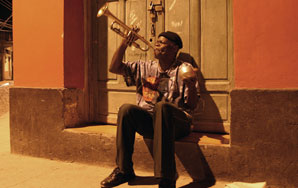A Story About New Orleans
I lived there for six of my 26 years, which locals will be quick to tell you is 20 years too few to have a real, valid opinion on the matter.

I’m writing to you today about New Orleans.
New Orleans has been written about on this site before. Written about well, in fact. (If you haven’t, I implore you to check out Ryan O’Connell’s delightful whirlwind visit to the city in his “Tits, Tears, And Frozen Daiquiris: A (Not So) Touristy Guide To New Orleans.”)
And I’m not even going to try and write the authoritative take on the Crescent City. I lived there for six of my 26 years, which locals will be quick to tell you is 20 years too few to have a real, valid opinion on the matter. I called the city my home for six years, yes, but I was only beginning to scratch the surface.
It is a place that takes time.
I could do the thing most writers do when trying to describe New Orleans, and talk about late nights in smoky bars, trumpets blaring sad notes, stumbling drunk out of Spotted Cat at 5:30 in the morning, looking for the next bar. I’m not going to do that.
What I will do is tell you a story of a building coming down. It happened this past weekend. After years of arguments and political maneuverings and (I’m sure) money exchanging hands, an old hotel was imploded. Blown up from the inside. It was called the Pallas Hotel. (It was also called, at one point or another, The Grand Palace… New Orleanians have never been too concerned with their spelling.)
The hotel was imploded to make room for a brand new Medical Center. This sounds good… but of course, this is New Orleans, so it’s a bit more complicated than that. The new Medical Center is replacing the old Charity Hospital, which was damaged in Katrina, but (many argue) probably didn’t need to come down and didn’t need to be replaced. (It’s really a lot more complicated than this, but I don’t want to bore you too much with the politics.)
Basically, an old hotel was scheduled to be imploded, and half the city was against it. There were legal hang ups, chicanery, etc. Then, finally, on Sunday, at about eight in the morning, the sucker came down.
And here, finally, I arrive at my point about what makes New Orleans different than other places. Why? Because on that Sunday morning, with this big building set to come down, and half the city enraged that it was doing so… everyone decided to throw a party.
Yep. A party. They woke up early (or, more likely, never went to sleep). Then they got together to watch the building come down.
And this, this is what separates New Orleans from other cities. Because in other cities you’ll have all the first part. The reaction to a controversial decision. You’ll have the political wheeling and dealing and the corruption (not as bad, but still). You’ll have the outraged citizens and the Change.org petitions and the outsized rhetoric. You’ll have the protests.
But only in New Orleans do the citizens of the city have the good sense to put the anger aside. To come together. When the moment comes, and the fight is over, they figure: “Well, hell. Might as well watch this sumbitch come down.”
And so they did. On that Sunday morning, bleary-eyed and hungover, with the taste of whiskey still on their lips, the people of the Crescent City gathered on the rooftops of the apartment buildings downtown. They put on their dust masks and poured Bloody Marys in solo cups, and in the morning haze they sat on fold-out chairs, girlfriends on boyfriends’ laps and, with an understanding that only New Orleanians have, that sometimes a rebirth requires death, they sat and watched, and cheered and hollered, as in the near distance the charge went off and the whole thing went boom. 

